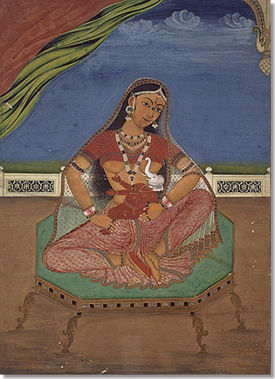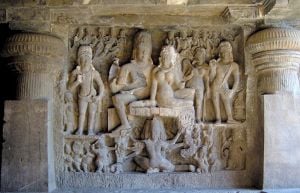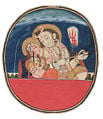Parvati
| ||||||||||||||||
Pārvatī (Sanskrit: पार्वती), sometimes spelled Parvathi or Parvathy, is the Hindu goddess best known for her domestic role alongside her husband Shiva, the ascetic god of destruction. Her name derives from Parvata, one of many Sanskrit words for "mountain"; "Parvati", then, translates to "She of the mountains" and refers to Parvati's status as daughter of Himavan, lord of the mountains. Parvati's numerous epithets include Uma, Lalitha, Gowri, Shivakamini, Aparna, the maternal epithet Mataji, and many hundreds of others.
Parvati is the mother of the famous gods Ganesha and Kartikeya. In many interpretations of the scriptures, Parvati is also regarded as a representation of Shakti or Durga, albeit the gentle aspect of that goddess because she is a mother goddess otherwise known as Devi. She has also been connected to Kali. Many of the believers of Shakta philosophy also consider her to be the ultimate Divine.
Mythology
Early Conceptions: Satī
Parvati originally appears as the goddess Sati, the first wife of Shiva who turns out to be an earlier incarnation of Parvati. Sati is the daughter of Daksa, whose existence revolves around making Shiva her husband. She was given this impetus by Brahma, the creator god. Earlier on in mythological history, Shiva had laughed reproachfully at when he had been stricked by incestuous lust for his own daughter. In order to exact some revenge, Brahma saw to it that Shiva would be seduced by sexual passion. Other texts, such as the Rudra-Samhita, show a more temperate Brahma suggesting that Shiva must become active in the creative world through Parvati so as to ensure the physical world will be imbued with auspiciousness.
Unfortunately for Parvati, Shiva is steeped in asceticism and is therefore difficult to convert to domestic life. However, through her own appeals to asceticism and devotion, she is able to attract Shiva's attention. She asks Shiva to marry him, and he agrees, having discovered a newfound desire for her. The marriage is traditional, despite Shiva's general impatience, with Brahma overseeing as the priest. Meanwhile, Daksa begins to express trepidations with Shiva's renunciate appearance and habits, and conflict develops between Sita's father and his future son-in-law. Afterward, Siva and Sati enjoy one another's company on Mount Kailash, while Daksa organizes a great sacrifice to which all divine beings are invited, save for Siva and Sati. Furious with her father's nagging disapproval of Shiva, Sati kills herself. This mythological event provided grounds for ancient Hindus to explain the custom of sati (suttee), a practice named for the goddess in which females would throw themselves upon the funeral pyre of their deceased husband.
Upon hearing of Sati's death, Shiva is furious and creates a variety of fierce beings including the deomn Virabhadra. These demons defeat the various divinities assembled at Daksa's grand sacrifice, and kill Daksa himself. Shiva then enters the sacrifice himself, and it proceeds without further issue. In alternative versions of the story, Shiva carries Sati's lifeless body all over the universe, causing various cosmic disturbances along the way. Vishnu follows Shiva throughout his tragic journey, slicing off parts of Sati's corpse which become sacred places, or pithas, wherever they land on earth. Thus, with these centres of worship established, Sati has made the inacessible, hidden divine represented by Shiva accessible to the physical world. Once all the parts of Sati's body are dispersed, Shiva returns to solitude ih his mountain abode.
Later Conceptions
Parvati is the daughter ofHimavat, the personification of the Himalaya mountains, and the apsaras Menā. Her origin as daughter of the Himalayas, as well as her name and many epithets which connect her to the mountains (such as Girisa: "mistress of the mountains"), suggest that she may have originated from a non-Aryan tribal goddess who dwelled in the mountains. However, Parvati's mythology does not describe her as goddess of mountain ranges or of the wild in general. [1]
Parvati is nominally the second consort of Shiva, the Hindu God of destruction and rejuvenation.
However, she is not different from Dakshayani, being the reincarnation of that former consort of Lord Shiva.
Attributes
Appearance
Symbolism
Parvati symbolises many noble virtues esteemed by Hindu tradition. Just as Shiva is at once the presiding deity of destruction and regeneration, the couple jointly symbolise at once both the power of renunciation and asceticism and the blessings of marital felicity. Kalidasa's epic Kumarasambhavam details with matchlessly lyrical beauty the story of the maiden Parvati; her devotions aimed at gaining the favour of Shiva; the subsequent annihilation of Kamadeva; the consequent fall of the universe into barren lifelessness; the subsequent nuptials, in these circumstances, of the partners of many previous births; the immaculate birth of Subrahmanya and the eventual resurrection of Kamadeva after intercession by Parvati to Shiva in his favour.
Parvati thus symbolises many different virtues esteemed by Hindu tradition: fertility, marital felicity, devotion to the spouse, asceticism and power. It is said in the Saundarya Lahiri, a famous literary work on the goddess, that she is the source of all power in this universe and that because of her, Lord Shiva gets all his powers. She is occasionally depicted as half of Lord Shiva.
Worship
Some of the famous temples where Parvathi forms are predominantly worshipped include,
- Meenakshi temple at Madurai
- Kamakshi Amman temple at Kanchipuram
- Akilandeswari temple at Thiruvanaikaval
- Shiv-parvati.jpg
Shiva-Parvati
- Shiva parvati01.jpg
Shiva and Parvati with Ganesh
- Shiva-parvati2.jpg
The divine couple as a symbol of fertility and marital felicity
- British Museum Lalita.jpg
Parvati as Lalita with Ganesha and Skanda, in the British Museum
Shiva and Parvati, a painting from Smithsonian Institute
Notes
- ↑ Kinsley, 41.
ReferencesISBN links support NWE through referral fees
- Kinsley, David. Hindu Goddesses: Vision of the Divine Feminine in the Hindu Religious Traditions. Berkeley: University of California Press, 1988. ISBN 978-0520063396
- Mitchell, A.G. Hindu Gods and Goddesses. London: Her Majesty's Stationery Office, 1982. ISBN 011290372X
Credits
New World Encyclopedia writers and editors rewrote and completed the Wikipedia article in accordance with New World Encyclopedia standards. This article abides by terms of the Creative Commons CC-by-sa 3.0 License (CC-by-sa), which may be used and disseminated with proper attribution. Credit is due under the terms of this license that can reference both the New World Encyclopedia contributors and the selfless volunteer contributors of the Wikimedia Foundation. To cite this article click here for a list of acceptable citing formats.The history of earlier contributions by wikipedians is accessible to researchers here:
The history of this article since it was imported to New World Encyclopedia:
Note: Some restrictions may apply to use of individual images which are separately licensed.



